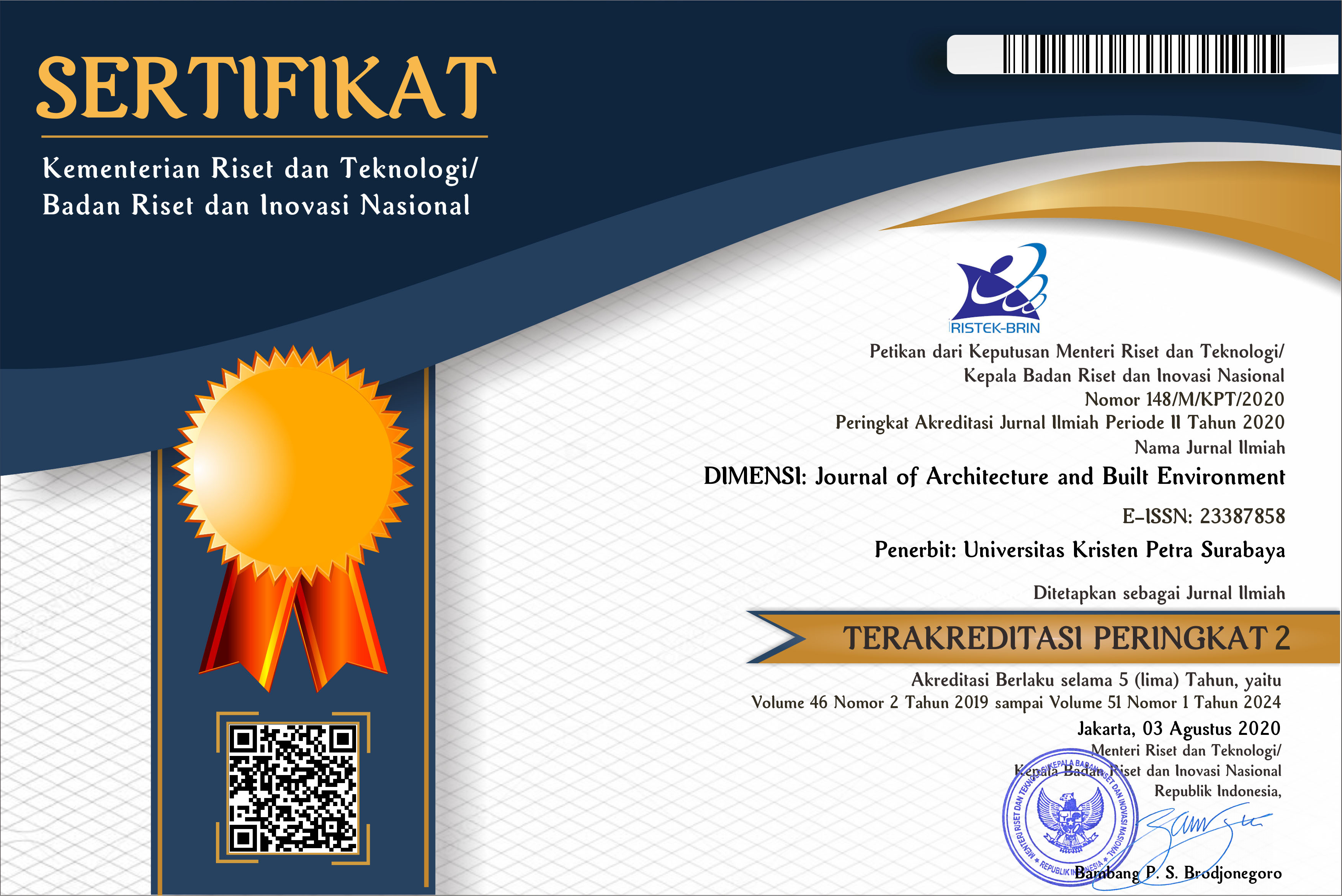COASTAL COMMUNITY PARTICIPATION IN KELURAHAN SUKOLILO, BULAK, BASED ON LOCAL ECONOMY
 :
:
https://doi.org/10.9744/dimensi.44.1.21-28
Keywords:
Coastal area, local economy, community participatoryAbstract
Kelurahan Sukolilo, Bulak Settlement is an area of fishermen settlement with great potential of resources such as fish and sea cucumber. Kelurahan Sukolilo also well known as Prominent Kampung in fish processed products. Despite having a great potential in marine resources, most of the fishermen still live in a low environmental and economic condition. Theres hould be effective environmental management in coastal area so the fiherman vulnerability can be reduced through a criteria of developing coastal area that is able to accomodate the fisherman economic activities. The researcher will apply community based development in developing coastal area criteria.. In this case community-based development approach needs to be developed in the management of coastal areas, especially for the improvement of the environmental quality. This is because the coastal characteristic and resources are very complex and diverse, so in the coastal area management should involve the local community directly. Community based management shows the importance of community participation in development planning and implementation. This research was in form of qualitative research, data sources obtained by primary and secondary data. Primary data were collected through observations, visual documentations and interview with the fishermen and fish processors. Secondary data were obtained from literature and theory. Research results showed that level of community participation that need to be done in the development process using active participatory. Active participatory should be done through partnership and delegated power level to accomodate fishermen and fish processors activities and support sustainable environment. Co-working space for inhabitants is needed to accomodate community activities related to water and odor and drying process and to create area to socializeDownloads
References
Adrianto, L. (2007). Approach and Fishery Program Evaluation Methodology: Participatory Qualitative Modeling. Bogor: Study Center of Coastal and Naval Resources, Agriculture Institutoon of Bogor.
Arnstein, S.R. (1969). “A Ladder of Citizen Participation”. Journal of the American Planning Association, 35(4), pp.216-224
Bungin, M.B. (2007). Penelitian Kualitatif: Komunikasi, Ekonomi, Kebijakan Publik, dan Ilmu Sosial Lainnya. Jakarta: Kencana Prenada Media Group.
Groat, L. & Wang, D. (2002). Architectural Research Methods. Canada: John Wiley & Sons,inc.
Harbison, F. & Myers, C. (1965). “Education, Manpower and Economic Growth: Strategies of Human Resource Development”. McGrrow-Hill Series in International Development, New York.
Kellet, P. & Tipple, G. (2000). ‘the home as workplace: A study of income generating activities within the domestic setting’. Environment and Urbanization, 12(1), pp.1-11.
Kulindwa, K. et al. (2008). The Human Dimension. Environment for Development. UNEP.
Neiland, A.E & Bene, C. (2004). “Poverty and small-scale fisheries in West Africa”. Dordrecht, Netherlands: Kluwer, Rome, Italy: FAO.
Nikijuluw, V.P.H. & Naamin, N. (1994). Current and future community-based fishery management in Indonesia. Indonesian Agricultural Research and Development Journal, 16(2), pp.19-23
Pomeroy, R.S. (1995). Community-based and co-management institutions for sustainable coastal fisheries management in Southeast Asia. Ocean & Coastal Management, 27(3), pp.143-162.
Rustiadi (2003). Pengembangan Wilayah Pesisir sebagai Kawasan Strategis Pembangunan Daerah. Makalah disampaikan dalam Pelatihan Pengelolaan dan Perencanaan Wilayah Pesisir secara Terpadu (ICZPM), kerjasama PKSPL IPB dengan Departemen Kelautan dan Perikanan.
Smith, T. & Doherty, M. (2006). The suburbanisation of coastal Australia. Paper prepared for the 2006 Australia State of the Environment Committee, Department of Environment and Heritage, Canberra.
Spradley, J.P. (1997). Metode Etnografi, terjemahan oleh: Misbah Zulfa Elizabeth, PT Tiara Wacana, Yogyakarta.
Utami, S. & Antaryama (2014). A Space Expansion Model For Productive Housing In Fish Processing Kampung. UIA2014 DURBAN Architecture OTHERWHERE. Cib W110 Informal Settlements & Affordable Housing.
Walter, B.L. & Larkin, R.C. (1992). Sustainable Cities: Concepts and Strategies for Eco-City Development. LA. Eco-Home Medi.
WCED (World commision on environment and developent). (1987). Our Common future (Brundlant Report).World commision on environment and dev.Oxford,oxford university pers.
Downloads
Published
How to Cite
Issue
Section
License
Authors who publish with this journal agree to the following terms:
- Authors retain copyright and grant the journal right of first publication with the work simultaneously licensed under a Creative Commons Attribution License that allows others to share the work with an acknowledgement of the work's authorship and initial publication in this journal.
- Authors are able to enter into separate, additional contractual arrangements for the non-exclusive distribution of the journal's published version of the work (e.g., post it to an institutional repository or publish it in a book), with an acknowledgement of its initial publication in this journal.
- Authors are permitted and encouraged to post their work online (e.g., in institutional repositories or on their website) prior to and during the submission process, as it can lead to productive exchanges, as well as earlier and greater citation of published work (See The Effect of Open Access).


















